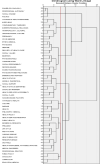Mapping the Intellectual Structure of Medical Sociology: A Co-Word Analysis
- PMID: 36407736
- PMCID: PMC9643228
- DOI: 10.18502/ijph.v51i5.9431
Mapping the Intellectual Structure of Medical Sociology: A Co-Word Analysis
Abstract
Background: Medical sociology is concerned with the relationship between social factors and health, and with the application of sociological theory and research techniques to questions related to health and the health care system. Considering the wide range of studies in the field that each examined different aspects, to promote health in community, bibliometrics analysis in this area is felt.
Methods: In this descriptive-analytical study with a scientometric approach, the data about "medical sociology" were retrieved from PubMed in MEDINE format, including 1226 records over the period 1945-2018. By using Co-word analysis, clustering methods, and strategic diagram with the help of SPSS, UcInet 6 software the data were analyzed.
Results: The keyword "Attitude to Health" and two pairs of frequently used keywords, namely "Power (Psychology)*Professional Autonomy" were the most frequent in medical sociology. The results shaped the concepts of medical sociology in 7 clusters. The clusters "Attitude of health personnel", "Health Policy" and "Sociology of Medical Education" are topics that may be emerging or disappearing. The "Physicians", "Models of Social Determinants of Health" and "medical philosophy" are immature clusters.
Conclusion: This research used co-word networks that indicate the important links between keywords of research areas. Considering the frequency of keywords along with the clusters obtained, it seems that the most research approach was seen on the medical aspect rather than the sociological aspect. Despite the importance of sociological aspects such as social rooting of disease, sociability, medicine as a social institution and etiological studies, these subjects have not been sufficiently considered.
Keywords: Bibliometrics; Co-word analysis; Medical sociology.
Copyright © 2022 Rohani et al. Published by Tehran University of Medical Sciences.
Conflict of interest statement
Conflict of interest The author declares no conflict of interest.
Figures
Similar articles
-
Scientometrics Analysis of Global Researches on Anemia.Int J Hematol Oncol Stem Cell Res. 2024 Oct 1;18(4):390-399. doi: 10.18502/ijhoscr.v18i4.16763. Int J Hematol Oncol Stem Cell Res. 2024. PMID: 39703475 Free PMC article. Review.
-
Fatemeh Makkizadeh Ph.D., Esmaeil Bigdeloo M.A.Int J Reprod Biomed. 2018 Jun 13;17(5):349-60. doi: 10.18502/ijrm.v17i5.4602. eCollection 2019 May. Int J Reprod Biomed. 2018. PMID: 31435612 Free PMC article.
-
Research hotspots and trends in nursing education from 2014 to 2020: A co-word analysis based on keywords.J Adv Nurs. 2022 Mar;78(3):787-798. doi: 10.1111/jan.15010. Epub 2021 Sep 12. J Adv Nurs. 2022. PMID: 34514616
-
Topic Analysis of Nursing Research Using Co-Word Analysis.Iran J Nurs Midwifery Res. 2021 Sep 2;26(5):417-424. doi: 10.4103/ijnmr.IJNMR_41_20. eCollection 2021 Sep-Oct. Iran J Nurs Midwifery Res. 2021. PMID: 34703780 Free PMC article.
-
Peculiarities of medical sociology: application of social theories in analyzing health and medicine.Medicina (Kaunas). 2007;43(2):110-7. Medicina (Kaunas). 2007. PMID: 17329945 Review.
Cited by
-
Scientometrics Analysis of Global Researches on Anemia.Int J Hematol Oncol Stem Cell Res. 2024 Oct 1;18(4):390-399. doi: 10.18502/ijhoscr.v18i4.16763. Int J Hematol Oncol Stem Cell Res. 2024. PMID: 39703475 Free PMC article. Review.
References
-
- Weber Elke U. (2001). Personality and Risk Taking. In International Encyclopedia of the Social and Behavioral Sciences. ed. Smelser Neil J., Baltes Paul B. Oxford: Pergamon, 11274–11276.
-
- He Q. (1999). Knowledge discovery through co-word analysis. Library Trends, 48: 133–159.
-
- Ravikumar S, Agrahari A, Singh SN. (2015). Mapping the intellectual structure of scientometrics: A co-word analysis of the journal Scientometrics (2005–2010). Scientometrics, 102(1): 929–955.
-
- Chen X, Chen J, Wu D, et al. (2016). Mapping the research trends by co-word analysis based on keywords from funded project. Procedia Computer Science, 1(91): 547–555.
LinkOut - more resources
Full Text Sources




